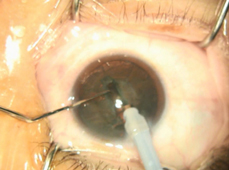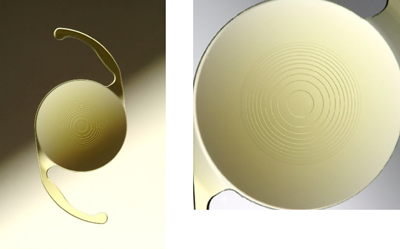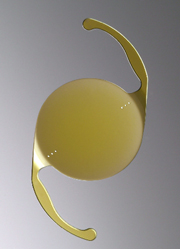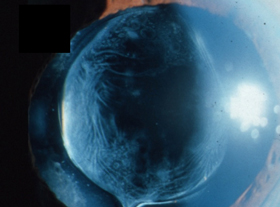Cataract Surgery Singapore
Cataract surgery is a very common procedure that is very effective for the treatment of cataracts. It is usually done as a day surgery procedure and overnight stay in the hospital is not necessary.
The cataract surgery is usually done using the phacoemulsification (“phaco”) method, and can be done under local anaesthesia using eye drops to numb the eye.
During “phaco”, the front portion of the “skin” of the cataract is removed to uncover the cataract. A tiny ultrasound device is then used to break up the cataract and suck out the fragments through an incision measuring 2.75mm or less.
The back portion of the “skin” of the cataract (capsule) is carefully retained during the surgery so that it can be used to support an artificial lens implant. The lens implant is inserted to help the eye see well after surgery. As the wound is very small, it is self-sealing and no stitching is necessary.

Cataract surgery in progress.

Modern cataract surgery is so advanced that the eye can regain its normal state within a very short time. This patient underwent cataract surgery only the day before.
Lens implants
Lens implants help the eye see well by focusing light on the central fixation point of the eye (macula). A large range of lens implants can now be used to correct pre-existing short-sightedness and long-sightedness. Premium lens implants can also correct astigmatism (散光) and/or presbyopia (lao-hua / 老花).

Artificial lens implanted in the eye to help focus light.
With a standard artificial lens (monofocal lens), vision is clear for 1 pre-determined distance. For example if you choose to implant a monofocal lens for good distance vision, reading glasses will usually be necessary to focus clearly on near objects after surgery.
However, those who hope to eliminate or reduce the need for reading glasses can consider multifocal lens implants which can give varying levels of distance, intermediate and near vision without glasses.

A multifocal lens has multiple built-in rings for focussing on different distances.
For those people who have high astigmatism, “toric” lens implants can be implanted to eliminate the need for astigmatic glasses after surgery.

A toric lens implant cancels out pre-existing astigmatism of the eye.
You will need to discuss with your eye surgeon which lens implants are most suitable for you. Your decision should be made based on your needs, lifestyle and pre-existing eye condition.
Make an appointment with our eye specialist for professional advice for cataract surgery.
FAQs about cataract surgery
After cataract surgery, can I perform regular daily activities like watching TV, reading, bending over and doing housework or cooking?
You may return to most of your routine daily activities the day after surgery. Activities such as reading, watching television, cooking, and light exercises will not affect the operated eye. However, you should refrain from swimming for a few weeks after surgery to avoid contaminating the operated eye. You should also avoid pressing on the eye. Check with your eye surgeon if you are not sure when you can return to doing a certain activity after surgery.
What sort of food should I avoid after cataract surgery? Can I resume taking my regular medication (for high blood pressure, diabetes, heart problems, etc) after surgery?
There are no special dietary restrictions after cataract surgery. If you are taking regular medication for other medical conditions, you should resume taking them after the surgery.
I have heard that vision can become blurred again months or years after cataract surgery. Is this because the cataracts have grown back?
The “skin” of the cataract (capsule) holding the lens implant may become cloudy months or years after surgery, resulting in blurring of vision again. This is “posterior capsule opacification” or “PCO”, and is easily treated with a simple laser procedure.

The capsule supporting the lens implant becomes cloudy after some time and may need to be cleared with a simple laser procedure.
